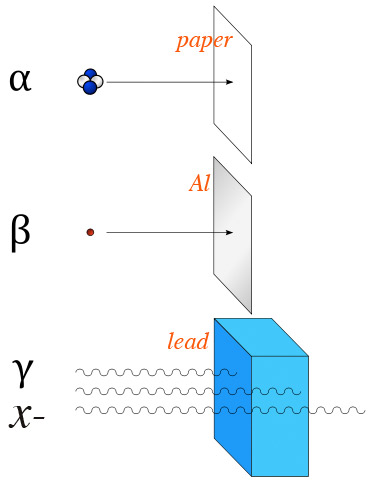Hazards of radiation
Ionizing radiation

These kinds of radiation can damage cells by knocking electrons out of molecular bonds--creating ions: charged molecules & free radicals.
Your body repairs some damage.
Biggest risk is to growing / dividing cells. Like...what?
- fetuses
- cancer cells
- rapidly growing bacteria (gamma irradiation of food.)<
And what would our labs suggest about the radioactivity of food or cancer patients who have been treated with radiation?
| damage potential | blocked by | |
| alpha, ${}_2^4He$ | high | paper |
| beta, $e^-$ | medium | Al sheets |
| gamma | low | thick lead |
| x-ray | low | moderate lead |
Alpha emissions are easily blocked. Problems occur when radioactive isotopes get inside your body--through eating or respiration--and can then emit alphas right next to a living cell.
Smoke detectors typically contain a small amount of an alpha emitter which is used to ionize $O_2$ and $N_2$ molecules.
Your skin's natural defense: It's already dead, and you're going to shed it
before long.

Hazards of electromagnetic radiation
The "photoelectric effect" shows that UV rays are needed to knock electrons loose. Visible or infrared or microwave rays do not have enough energy to knock out electrons.
This is the basis of my lack of concern about powerlines / cell phones / electric blankets. They emit lots of radiation, but the radiation cannot knock out electrons (or break chemical bonds...)
Radiation in you and me
 Your body contains small amounts of naturally occurring radioactive isotopes.
The two main ones:
Your body contains small amounts of naturally occurring radioactive isotopes.
The two main ones:
- Potassium-40: 0.01% of all potassium; $\beta$ emitter; ~1,000 explosions / sec.
- Carbon-14: 0.00000000001% of all carbon; $\beta$ emitter; ~3,000 explosions / sec.
Cell damage
Cell damage is measured in Sieverts (Sv). 1 Sv is approximately equivalent to 200 billion gamma rays penetrating each 1 square cm of an average body. The following are full body doses in milliSieverts ($10^{-3}$ Sieverts)
0.01 mSv - Approximate dose from one dental x-ray. Well, this one is concentrated on your jaw, not spread out.
0.16 mSv - "Self" radiation.
3 mSv - U.S. average annual dose.
1 mSv - EPA says a sudden dose of this much leads to 0.8% increase in risk of cancer according to the Linear Hypothesis.
200 mSv - Approx dose received by each of 52,000 Hiroshima survivors.
260 mSv - annual naturally occurring radiation exposure in Ramsar, Iran.
500 mSv - peak civilian exposure (est) from one nuclear test in Kazakhstan.
1000-2000 mSv - nausea, loss of hair, rarely fatal.
5000 mSv - 50% chance of death after sudden exposure to this much radiation. Read more about the Goiania accident in Brazil.
25,000 mSv - "Cancer dose"
Really means: if you expose a larger group of people to 25,000 mSv, there will be one more death than would have occurred otherwise.
[A table of allowed and estimated exposures.]
Hiroshima and cancer [In-class writing]

Human beings in Hiroshima, Japan, when the Allies exploded the first atomic bomb:
| 50,000-150,000 killed within days |
|
| ~52,000 survivors | Survived, but received an average radiation dose of ~200 mSv |
Total dose to survivors: 0.2 Sv * 52,000 $\approx$ 10,400 Sv.
According to the Linear Hypothesis, there should be one extra death due to cancer for each 25 Sv a population receives:
- Figure out the number of
excess cancers expected due to this radiation dose. It may help to
think about units when you decide what to multiply or divide by what:
10,400 Sv
$\frac{25 \,{\rm Sv}}{1\, {\rm cancer}}$
______ excess cancers--the units are "cancers"(well really, deaths due to cancer.) Hint: If you get *more* deaths due to cancer than 52,000 (the number of exposed people) something is wrong with your calculation!
______ % Using the low figure of 50,000 immediate deaths, what percentage is this (excess cancers) / (immediate deaths)?
- Your lifetime
probability of developing cancer is about 20%. So, how many of these
52,000 survivors would you have expected to die of cancer even without
the Hiroshima bomb?
______ number of "naturally occurring" cancers.
The Linear Hypothesis is cautious. It probably overestimates the dangers of radiation. Some people believe it would be more appropriate to use a _threshhold model_ for the dangers of radiation exposure.
Image credits
ionizing radiation, Tosaka, Nick Sherman, Łukasz Strachanowski